#Colorado History
Explore tagged Tumblr posts
Text

Colorado Pride Typography Art
#Colorado map#Colorado state#Colorado typography#Colorado word cloud#Colorado landmarks#Colorado gifts#Colorado pride#Colorado LGBTQ#Colorado rainbow#Colorado equality#Colorado decor#Colorado travel#Rocky Mountain map#Colorado illustration#Colorado history#lgbtq#lgbtqia#lgbt pride#lgb alliance#lgbtq community#queer pride#queer#trans pride#gay pride#pride#lgbt
2 notes
·
View notes
Text

📸: Airlia "Lia" Russell / @mx-bequiet, 2024
i've lived within a block of this house for at least 1/3rd of my life, and still have never visited the inside. there's a cute little free library around the corner of the yard, i love seeing those in the wild.

📸: Airlia "Lia" Russell / @mx-bequiet, 2024
"This 1890 brick two-story Queen Anne victorian style home is the oldest of the nine remaining houses associated with the early development of Aurora, originally known as the town of Fletcher. It was the first house Donald Fletcher built for his speculative community east of Denver. Like all Fletcher homes, it has indoor plumbing and upstairs bathroom, a luxury considering both the time period and the arid surroundings. The city of Aurora purchased the house in 1990 and community builders restored it for the City's Centennial year. It is representative of the town's development and the suburban movement at the turn of the century in Denver."
(copied from www.dar.org)
#mxbequiet#camilla the cat#scrapingfetusoffawheel#silly camilly#colorado#colorado history#aurora colorado#denver colorado#fletcher colorado#aurora#denver#1800s#1890s#queen anne style#victorian style#old house
2 notes
·
View notes
Text
Cathay Williams, first African-American woman to serve in the U.S. Army

November 15, 1866: Cathay Williams became the first African American woman to serve in the U.S. Army, and the only woman to serve in the U.S. Army as a Buffalo Soldier.
Williams was born to an enslaved mother and a free father in Independence, Missouri in 1844. At 17 years old, Williams first served as an Army cook and a washerwoman. During this time, African Americans who had been captured were forced to serve in military support as contraband for Union forces. Williams enlisted in the U.S. Regular Army under the false name “William Cathay” on November 15, 1866. She was assigned to the 38th U.S. infantry Regiment, one of the all-black regiments recently established, that would become part of the renown Buffalo Soldiers. The Army did not require full medical exams at the time, so she was able to pass as a man.
When Williams began to feel the effects of smallpox and was hospitalized, it was discovered that she was actually a woman. Lewis was honorably discharged by her commanding officer, Captain Charles E. Clarke, on October 14, 1868. Following her discharge, Williams went to work as a cook at Fort Union, New Mexico, and later moved to Pueblo, Colorado. Around 1889 or 1890, Williams entered a hospital and applied for disability pension based on her medical service. Her request was denied. In 1893, a doctor’s examination revealed that Willaims suffered from neuralgia and diabetes. She had all her toes amputated and walked with a crutch. The doctor determined that she did not qualify for disability payments. While the exact date of her death is unknown, it is believed that Williams died shortly after she was denied.

Williams’ interview that was published in the St. Louis Daily Times on January 2, 1876:
"My Father a was a freeman, but my mother a slave, belonging to William Johnson, a wealthy farmer who lived at the time I was born near Independence, Jackson county, Missouri. While I was a small girl my master and family moved to Jefferson City. My master died there and when the war broke out and the United States soldiers came to Jefferson City they took me and other colored folks with them to Little Rock. Col. Benton of the 13th army corps was the officer that carried us off. I did not want to go. He wanted me to cook for the officers, but I had always been a house girl and did not know how to cook. I learned to cook after going to Little Rock and was with the army at The Battle of Pea Ridge. Afterwards the command moved over various portions of Arkansas and Louisiana. I saw the soldiers burn lots of cotton and was at Shreveport when the rebel gunboats were captured and burned on Red River. We afterwards went to New Orleans, then by way of the Gulf to Savannah Georgia, then to Macon and other places in the South. Finally I was sent to Washington City and at the time Gen. Sheridan made his raids in the Shenandoah valley I was cook and washwoman for his staff I was sent from Virginia to some place in Iowa and afterwards to Jefferson Barracks, where I remained some time. You will see by this paper that on the 15th day of November 1866 I enlisted in the United States army at St. Louis, in the Thirty-eighth United States Infantry Company A, Capt. Charles E. Clarke commanding. Captain Charles E. Clarke in the Civil War 6th Infantry at the Battle of Baton Rouge. "The regiment I joined wore the Zouave uniform and only two persons, a cousin and a particular friend, members of the regiment, knew that I was a woman. They never 'blowed' on me. They were partly the cause of my joining the army. Another reason was I wanted to make my own living and not be dependent on relations or friends. Soon after I joined the army, I was taken with the small-pox and was sick at a hospital across the river from St. Louis, but as soon as I got well I joined my company in New Mexico. I was as that paper says, I was never put in the guard house, no bayonet was ever put to my back. I carried my musket and did guard and other duties while in the army, but finally I got tired and wanted to get off. I played sick, complained of pains in my side, and rheumatism in my knees. The post surgeon found out I was a woman and I got my discharge. The men all wanted to get rid of me after they found out I was a woman. Some of them acted real bad to me. After leaving the army I went to Pueblo, Colorado, where I made money by cooking and washing. I got married while there, but my husband was no account. He stole my watch and chain, a hundred dollars in money and my team of horses and wagon. I had him arrested and put in jail, and then I came here. I like this town. I know all the good people here, and I expect to get rich yet. I have not got my land warrant. I thought I would wait till the railroad came and then take my land near the depot. Grant owns all this land around here, and it won't cost me anything. I shall never live in the states again. You see I've got a good sewing machine and I get washing to do and clothes to make. I want to get along and not be a burden to my friends or relatives."
youtube
Leticia Wright stars in the 2023 film Surrounded. Her character, Moses “Mo” Washington, was modeled after the Cathay Williams. I’m also seeing a bit of Stagecoach Mary in Wright’s character.
Source: Smithsonian's National Museum of African American History and Culture Facebook, National Park Service, YouTube
Visit www.attawellsummer.com/forthosebefore to learn more about Black history and read new blog posts first.
Need a freelance graphic designer or illustrator? Send me an email.
#Cathay Williams#women in the military#U.S. Army#Buffalo Soldier#1800s#Missouri#1860s#American history#Black history#William Cathay#Colorado history
2 notes
·
View notes
Text
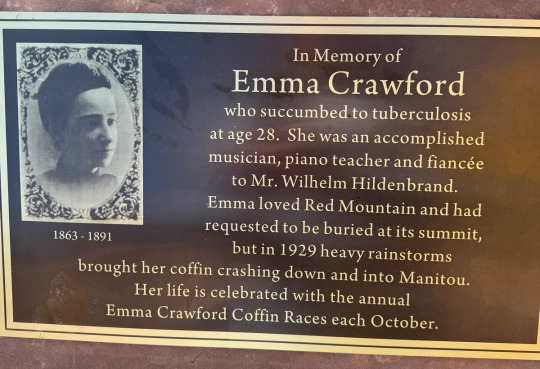
Text: "In memory of Emma Crawford who succumbed to tuberculosis age 28. She was an accomplished musician, piano teacher, and fiancee, to Mr. Whilhelm Hildenbrand. Emma loved Red Mountain and had requested to be buried at its summit, but in 1929 heavy rainstorms brought her coffin crashing down into Manitou. Her life is celebrated with the annual Emma Crawford Coffin Races each October". Ose song time
#colorado history#what a way to be remembered#do they race down the mountain?#how does one steer a coffin
3 notes
·
View notes
Text
Hometown Hero: Pvt. Joe P. Martinez and the Battle of Attu
At the intersection of 16th Street and 35th Avenue in Greeley, Colorado is a park. Now, you might be thinking that’s no big deal. Most cities have a park. So true. But this one is special. Located near that intersection is the Weld County Veterans Memorial and it’s “dedicated to the men and women of Weld County who have served our country in times of peace and war, and especially to those who…
#American Soldiers#Ault Colorado#Battle of Attu#CMF#Colorado#Colorado history#Congressional Medal of Honor#General Frank Culen#Greeley Colorado#Hispanic CMH winner#Hispanic soldiers in World War II#hispanic warheros#History#Pvt Joe P Martinez#Weld county#Weld county veterans mrmorial#World War II
0 notes
Text

0 notes
Text










I visited Branson CO today. Super neat place. The population is about 53 as of the 2020 Census, and they have no real store, gathering place, or anything. They do have an impressive school and field but focuses on online classes throughout Colorado.
It’s also apparently the southernmost town in Colorado, being less than a mile from the Colorado/New Mexico Border.
There is no functioning Gas Stations here, so the closest is 40 miles South in NM, or 35 miles east to Kim, or 40 miles West to Trinidad.
1 note
·
View note
Text

"SUICIDES END A PRISON RIOT," The Mercury (Manhattan, Kansas). October 4, 1929. Page 1. ---- COLORADO UPRISING ONE OF BLOODIEST IN THE NATION'S HISTORY ---- RINGLEADERS SUICIDE ---- Revolt Leases in Its Wake a List of 12 Known Dead and Many Wounded Some of Whom May Die Guards Killed in Cold Blood ---- Canon City, Colo, Oct. 1 (AP) - Due of the bloodiest prison mutinies in the nation's history came to an end at dawn this morning with the suicide of four leaders of the rebellion in the Colorado stare penitentiary.
The mutiny left in its wake list of 12 known dead and many wounded, some of who may die.
Four ringleaders of the mutiny barricaded with more than 150 other convicts in cell house No. 3, surrounded by troops, police and prison guards, and hopelessly outmumbered, first killed a wounded comrade and then fired bullets into their own brain.
The other convicts then surrendered and were marched out of the cell house just at sunrise. Four of the dead were prison guards, disarmed and slaughtered in cold blood inside the cell house, to emphasize the convicts' demand for unmolested freedom. Warden, Crawford, who declined all offer in parley with the embattled prisoners was himself wounded during one of the attacks on the cell block.
Dynamite Used National guard troops and police details from four Colorado cities fired more than 7.000 rounds of ammunition into the convict stronghold during the night. The battle was marked be the attempt to dynamite the cell house wall, one blast breaking all the windows but failing to effect a breach in the masonry.
The hero of the dynamiting attempts was a Catholic priest Father Patrick O'Neill, who carried the bombs to the foot of the cell house wall, under cover of machine gun fire from the prison walls.
In all seven prison guards were killed, three al the outbreak of rioting Thursday morning and four more during the night.
Those killed in the early rioting were Roy Brown, Walter Rinker and Elmer G. Erwin.
Those slaughtered in the cell house were John J. Ettes. Robert A. Wiggins, Charles Shepherd and John W. McClelland.
The convicts dead included Danny Daniels, who led the rioting, and acted as executioner of the guards; Charles Davis. A. Η Davis, George (Red) Riley and James Pardue.
Killed by Comrade Pardue was wounded in the abdomen during the early rioting.
He was removed to cell house No. 3 by the other convicts. He was found this morning with a bullet through his head, fired by one of the other convicts to end his suffering.
Three of the other ring leaders were found dead in the same cell, powder burns on their temples bearing mute testimony to shots fired at close range. The body of Daniels was in the doorway crawled half in and half out of the cell.
The floor of the cell house, which host night served as the execution chamber of four unarmed guards, was slippery with blood. The bodies of Charles Shepherd and John W. Clelland, two of the slain guards were found in the cell house, found hand and foot. Both had been shot through the head.
Close estimates is the time of the suicides the riot leaders at 4 a. m. but was not until an hour and a half later, at daybreak when O. E. Karl, one of the surviving guards, made his way to the prison yard, that the attacking forces learned of the fact, entered the cell house and rounded up the prisoners.
Afraid to Leave Earl said he was afraid to leave the cell house until daylight, for fear of being mistaken for a convict and shot by the watchers on the walls. With him in the cell house were John Pease and Lawrence Roche, who escaped the fury of the convicts, Roche's sister Josephine, secretary Crawford, had to remained at the prison all night, fearing each to see her brother's bullet body tossed out of a window the cell house, as the bodies Elles and Wiggins were tossed out.
Giving her brother up for she had left the prison shortly before daylight. When she learned that he was alive, she collapsed.
Gutted by fire, which destroyed the dining room and chapel and two of the cell houses and scarred by machine gun bullets and dynamite, the prison yard this morning was utter ruin.
One of Guards Mad Marvin Duncan, one of the guards in the cell house, was carried to a hospital this morning stark mad from terror. He was found locked in a cell and it was necessary to take off the door to get him out. He was at first thought to he dead, but examination revealed he was not even wounded. He saw Elles, prison hangman, shot down and saw his body tossed out of the cell house window.
He stood by while "Danty" Daniels asked Abe Wiggins, another guard if he had said his prayers.
"Yes," Wiggins replied without of emotion. "Where do you want me to stand"
He heard Daniels say "right where you are." and saw a bullet fired through Wiggins' head.
He heard Daniels tell John Shea, another guard, to take Wiggins body out to the warden, and fell him that Marvin Duncan would be the next guard to die.
That was at 9:30 o'clock. From then until he lost his mind, he expected each moment to be his last. Prison physicians said his condition resembled shell shock.
Warden Crawford today estimated the damage to the penitentiary at between $300,000 and $400,000. All the cell blocks except No. 3, in which the mutinous convicts were barricaded, were destroyed by fire, and number three is badly damaged, he said.
#colorado state penitentiary#cañon city#prison riot#prison guards#hostage taking#prison hostage taking#prison violence#causes of prison riots#colorado history#history of crime and punishment#the great depression
1 note
·
View note
Text
The real Carrie Ingalls from Little House in the Prairie briefly lived in Colorado
Carrie Ingalls Swanzey was the younger sister of famous "Little House on the Prairie" author Laura Ingalls Wilder. The cold climate of the north was hard on Carrie' asthma. She traveled to several places.
Carrie Ingalls Swanzey was the younger sister of famous “Little House on the Prairie” author Laura Ingalls Wilder. The cold climate of the north was hard on Carrie’ asthma. She traveled to several places in her young adulthood seeking a more comfortable climate, including Colorado and Wyoming. During her late-teen years Carrie was a typesetter for the De Smet News in South Dakota. Along with…

View On WordPress
#boulder Colorado#carrie ingalls#Colorado History#historical book#ingalls family#laura ingalls#little house on the parairie
0 notes
Text
Mesa Verde National Park - Cliff Dwellings in Colorado
youtube
Mesa Verde National Park was established in June of 1906 by President Theodore Roosevelt. It protects almost 5,000 archaeological sites, including 600 cliff dwellings!
1 note
·
View note
Text

Source

#immigration#abolish ice#history repeats itself#politics#us politics#government#progressive#Colorado#important#current events#news#deportations
2K notes
·
View notes
Text
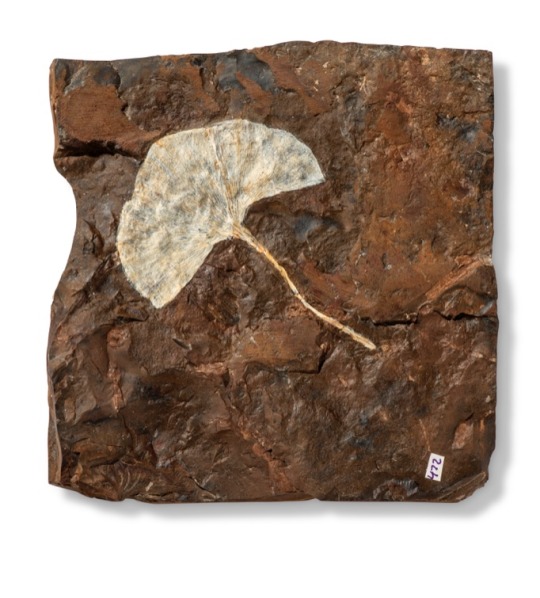

A FOSSIL GINKGO LEAF Colorado, USA
From the Paleocene (circa 58 - 55 million years ago) the clearly defined 31⁄4-inch wide Ginkgo cranei with well preserved striations, on original matrix. Reverse of matrix three further partial specimens of Ginkgo cranei.
63⁄4 x 67⁄8 x 3⁄4in. (17.1 x 17.5 x 1.9cm.).
#A FOSSIL GINKGO LEAF#colorado#paleocene period#ginkgo cranei#fossils#archeology#archeolgst#history#history news#ancient artifacts#nature
9K notes
·
View notes
Text
Lincoln Home, social services for Black Americans in early 20th century Pueblo, Colorado
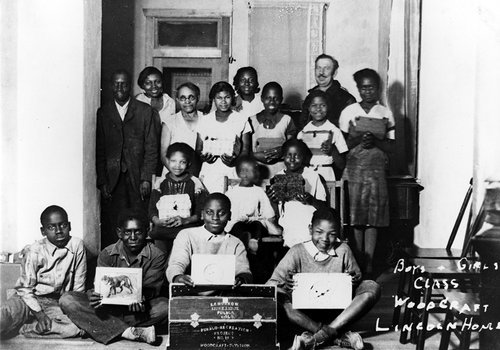
In 1905 The Colored Orphanage and Old Folks Home was known as, "the only home for colored children in an area of seven states." The Lincoln Home was started by the Federation of Colored Women’s Clubs in the city of Pueblo and became the only known Black orphanage in Colorado. Built in 1906, the home moved in 1914 to two small red-brick houses that were built closely together on 2714 North Grand Avenue, where it remained until the city’s segregated orphanage system ended in 1963. In 1997 the Lincoln Home building on North Grand Avenue was listed on the State Register of Historic Properties, and in the early 2000s the building housed the Martin Luther King Jr. Cultural Center. Currently the building serves as a museum which is open to the public and can be toured. Which was a huge honor for Pueblo, Colorado.

Pueblo’s Black community traces its roots to the diverse residents of El Pueblo, the early trading post that was built near the present city in the 1840s. According to the Colorado Encyclopedia, after the Colorado Gold Rush and the Civil War, new Black residents arrived from border states such as Kentucky and Missouri. Between 1870 and 1880 Pueblo County’s Black population grew from 27 to 141. The area’s Black population continued to grow over the next two decades. By the early 1900s, Pueblo’s Black community was developing its own institutions, including the city’s first black newspaper.




Ray Brown and Emily Wilson, Pueblo Heritage Museum Museum Curator and Executive Director, hope to find a home for artifacts from from the Lincoln Home that were collected by Pueblo civil rights icon and Brown’s mentor Ruth Steele. Read the detailed article on their efforts in The Gazette here.

Source: Pueblo Orphanages: Transformation, Pueblo County Historical Society Facebook, The Gazette
Visit www.attawellsummer.com/forthosebefore to learn more about Black history and read new blog posts first.
Need a freelance graphic designer or illustrator? Send me an email.
#Lincoln Home#Pueblo Colorado#Colorado#Colorado history#American history#Black history#orphange#social services#20th century Colorado history#segregation
2 notes
·
View notes
Text

Quick stop to admire Agathla Peak on a road trip from Colorado to Arizona.
Monument Valley
1977
#vintage camping#campfire light#road trip#el capitan#agathla peak#history#colorado#arizona#monument valley#1970s
3K notes
·
View notes
Text

Engineer Henry Nissen in overalls, poses in front of Denver and Rio Grande Western Railroad locomotive #488 (2-8-2), it heads passenger train #215, the "San Juan," on its last run in Alamosa, Colorado. January 31, 1951
158 notes
·
View notes
Text
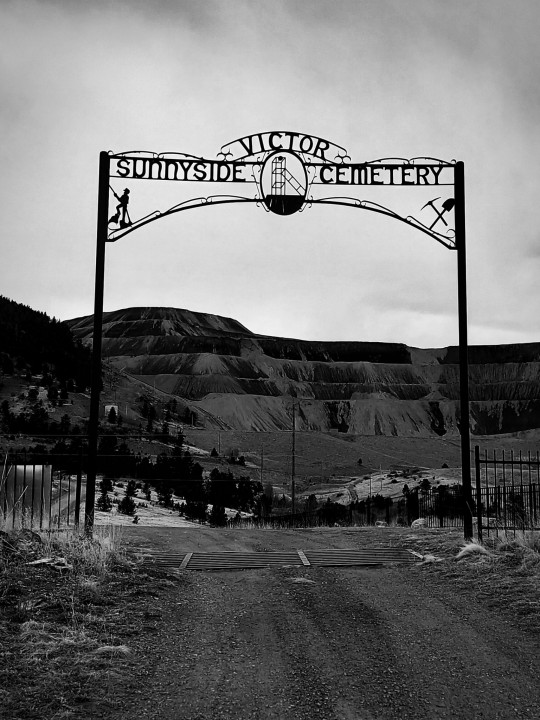

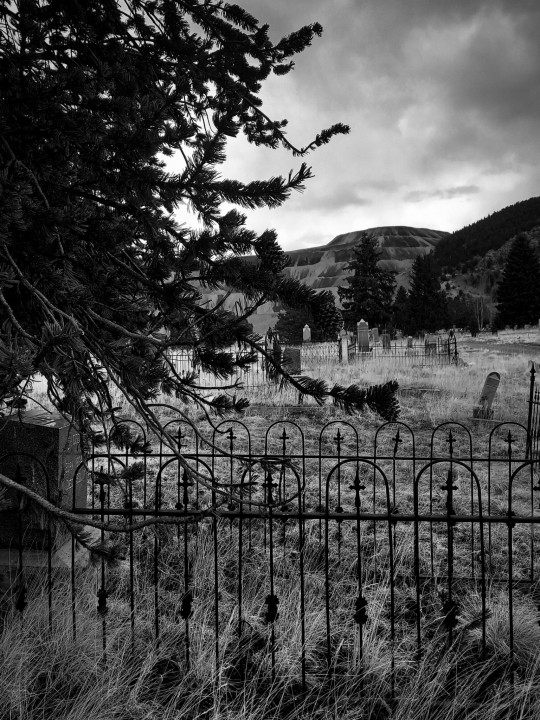


Sunnyside Cemetery, Victor, Colorado.
[Finding places where the wooden memorials are still standing is incredible!]
#colorado#photography#cell phone photography#black and white photography#cemetery photography#gravestones#headstones#american gothic#cowboy#cowboy aesthetic#old west#american history#metal#goth#there was VERY FRESH bear scat around here that made me ridiculously nervous
168 notes
·
View notes